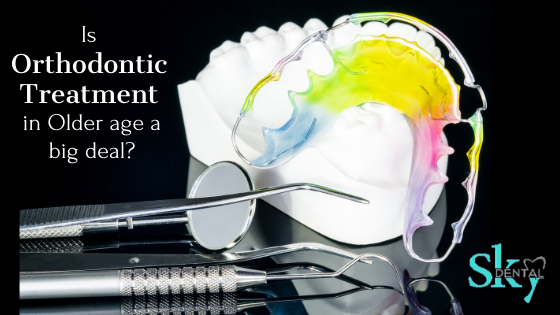Orthodontic treatment is a way of arranging your teeth to improve their appearance and function. The improper alignment of teeth can lead to joint compilations.
Why should you consider getting orthodontic treatment in older age?
Most of the people assume that dental braces are only for children and teenagers, which is so not true! People at any age can get braces even those who are over the age of 50. Braces aren’t just for teenagers. Of course, teenage teeth and jaws are certainly more malleable but there is also a great result for adult patients too.
Over 50’s you can lose collagen. This affects your skin and also the mouth, making your lower teeth more visible with age. As a result, this leads your teeth to become crocked or loose. If a crocked tooth is bothering you or perhaps your earlier straightened teeth have returned to their original position, orthodontic treatment suits best for you.
Are you too old braces?
Regardless of age, everyone would want to be healthy and good looking. Crowded or crooked teeth can be difficult to clean and it may also affect your dental health. As a result, this misaligned tooth can lead to tooth decay and gum disease more likely. Poor tooth alignment can lead to malocclusion or bad bite that causes chewing and swallowing problems. However, misalignment of the tooth is also difficult to pronounce certain words and can put an excess of stress on chewing muscles.
If you are considering orthodontic treatment to correct bite problems or to the alternate solution of the effects to tooth loss, consider the few things in mind
- In the older age, the growth of the bone stops. So, some of the structural changes should be accomplished with surgery.
- The process may take longer for you than a child. Straightening teeth process may vary from person to person. On average, treatment lasts about two years.
- If you are already undergoing orthodontic treatment, you may also need to consult a periodontist as well as general dentist and orthodontist to ensure that the treatment is not complicated by bone loss resulting from gum disease.
When to consider orthodontic treatment
- A bad bite or malocclusion causing overlapping of the teeth.
- Crowded or spaced apart teeth, which causes tooth decay or gum disease.
- Abnormal jaw pain caused by a crocked or chipped tooth.
- Difficulty in chewing food.
- Speech issues and swollen gums.
- The desire for healthier mouth and appearance.
Treatment options for Adults
Orthodontic treatment options nowadays offer a wide variety of braces and appliances that are comfortable to meet your needs. Types of braces include
Clear Ceramic braces: These are customized to match the colour of teeth. These are less noticeable and can blend easily.
Metal Braces: Metal braces consists of brackets and wires, with the use of high-grade stainless steel. These type of braces are best suitable for the extreme case of malocclusion.
Lingual Braces: These are hidden i.e, attached to the back of the teeth. If you are looking for completely invisible braces, lingual braces are the best choice for you.
Clear aligners: Clear aligners are specially for adults and allows aligning the tooth in a smooth without screws or brackets.
This article is intended to promote understanding of and knowledge about general oral health topics. It is not intended to be a substitute for professional advice, diagnosis or treatment. Always seek the advice of your dentist at a dental hospital in Vijayawada qualified healthcare provider with any questions you may have regarding a medical condition or treatment



Every person will respond differently to braces, but it is important to talk to your orthodontist about options for lessening pair or irritation. When all is said and done, the rewards of orthodontic treatment far outweigh the discomfort that may be experienced. When you initially receive your braces or after receiving some adjustments, your mouth may perhaps be tender. Over the counter pain relievers can really help minimize the pain as necessary. Fortunately, a majority of the orthodontic appliances today are made less bulky and smaller meaning treatment will be more comfortable and subtle than old fashioned orthodontic appliances.